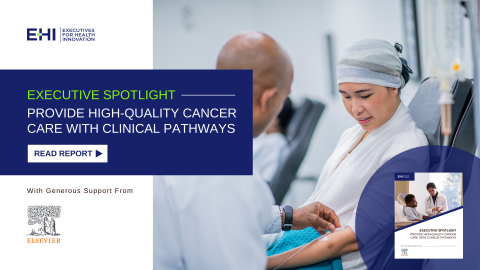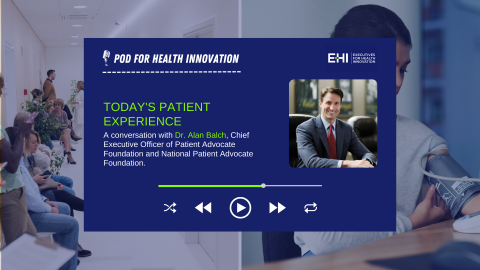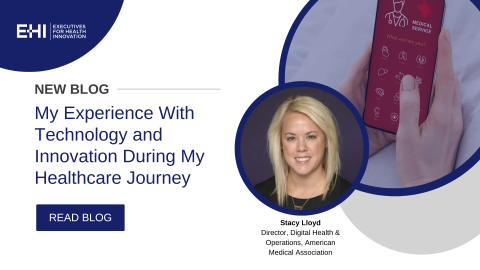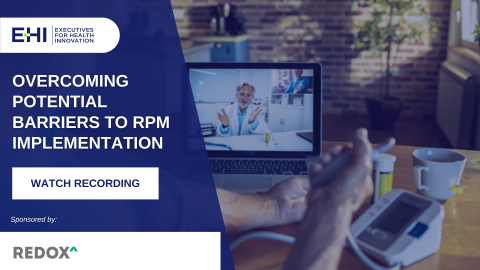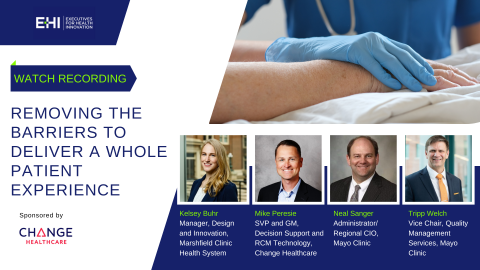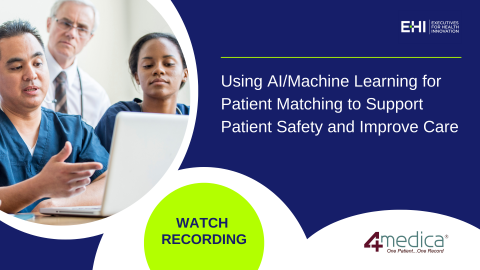Executive Spotlight: Provide High-Quality Cancer Care with Clinical Pathways
Overview
Clinical pathways enable providers to deliver evidence-based healthcare to patients. They provide treatment guidance based on the latest research and support standardization of care. Oncology practices implement pathways to ensure care is at the highest standard of quality, access, affordability, and health outcome.
Executives for Health Innovation (EHI) convened a group of oncologists and pathway experts at an executive roundtable, followed by a public webinar. The group discussed the appropriate use of clinical pathways in oncology and answered relevant questions around the topic from other oncology leaders.
This report highlights key takeaways from those discussions.
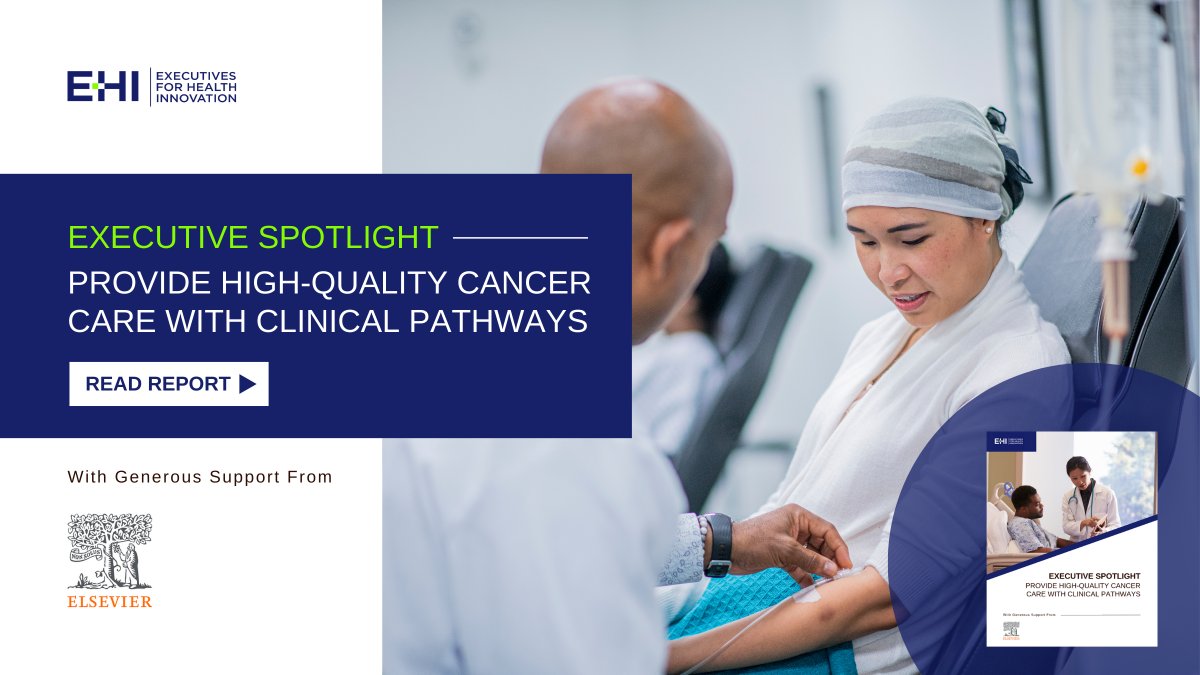
EHI thanks Elsevier for their generous support of our organization’s work addressing digital care and innovations improving health.

Podcast: A Conversation with Dr. Alan Balch on Today's Patient Experience
Overview
During this episode, we had the pleasure of speaking with Dr. Alan Balch, chief executive officer of Patient Advocate Foundation and National Patient Advocate Foundation. Dr. Balch addresses the challenges and obstacles that patients face today when attempting to access and/or receive care in the U.S. healthcare system. In addition, Dr. Balch describes the Advocate Foundation and National Patient Advocate Foundation's important work in helping patients navigate a complex system to receive needed care.

Alan Balch, PhD
Chief Executive Officer
Patient Advocate Foundation and National Patient Advocate Foundation
Dr. Balch is the Chief Executive Officer of Patient Advocate Foundation and National Patient Advocate Foundation.
Dr. Balch has nearly fifteen years of executive leadership in the non-profit sector with an emphasis on consensus-building and collaboration. He has led numerous federal advocacy efforts on a range of issues both at the legislative and regulatory level over the years. He became the CEO of both PAF and NPAF in 2013. From 2006 – 2013, he served as the Vice President of the Preventive Health Partnership — a national health promotion collaboration between the American Cancer Society, American Diabetes Association, and American Heart Association. Prior to his work with the Preventive Health Partnership, Dr. Balch was the Executive Director of Friends of Cancer Research.
Dr. Balch has served on the Executive Board of the Patient Advocate Foundation and National Patient Advocate Foundation since 2007. Dr. Balch also serves on numerous advisory boards and committees
He earned his PhD in environmental studies with a concentration in political economy in 2003 from the University of California, Santa Cruz; his master’s degree in environmental sciences in 1997 from the University of Texas in San Antonio; his bachelor’s degree (cum laude) in biology in 1994 from Trinity University in San Antonio.
Blog: My Experience With Technology and Innovation During My Healthcare Journey
As I think about the patient experience and how it’s evolved over the years, I am optimistic about the continued transition away from patient satisfaction scores on a Press Ganey survey and towards a more holistic approach to thinking about how patients and caregivers navigate, access, use and experience the broader healthcare system. Patient experience was a priority for many health systems prior to the COVID-19 pandemic, but the way care is delivered has drastically changed since then, and so have patient expectations.
Improving the patient experience is personal for me. At the age of 10, I was life-flighted to Children’s Hospital of Pittsburgh with a blood pressure of 240/120. I would soon be diagnosed with Pheochromocytoma, a type of tumor found on the adrenal glands that causes hypertension and various other symptoms. I spent a majority of the next month in the hospital being stabilized, followed by a 12-hour surgery to remove two tumors. Following another 10-hour surgery for a similar tumor three years later, my family was sent to the National Institutes of Health for further testing.
I was officially diagnosed with a rare, genetic disease called Von Hippel-Lindau (VHL), which causes people to grow tumors in up to ten (10) areas of the body. There’s currently no cure and surgery is the most common form of treatment (if and when it’s possible). This diagnosis started a trajectory that would change my life forever and truly require me to rely on the healthcare system for the rest of my life. Since those early years, eight (8) other members of my family have been diagnosed with VHL, I’ve had two (2) additional related surgeries, and I complete annual surveillance that includes MRIs, CTs, blood work, eye exams, etc.
The use of healthcare technology and innovation is a critically important aspect of care delivery for patients, and it has and will continue to play a major role in my healthcare journey. While I got sick at a time that healthcare tech consisted of EHRs at best, as I’ve gotten older and the industry has evolved, digital health has become a regular in my care routine in a few ways.
Tools that help coordinate care
I’ve moved across states multiple times and have had to identify new care teams. I’ve leveraged patient portals to access, secure, and/or share my medical records with new clinicians ahead of my first visit. Patient portals have also been a helpful way for me to remain engaged by viewing my results and comparing them against past years, and have made it easier to request appointments and/or ask questions to my physicians. Digital front doors can provide positive experiences for patients if done right and truly support patients in navigating the system.
I have also used a tool that records conversations with my physician to refer back to later. The app provides transcription of the visit that helps break down the medical terminology, provides information on potential prescription and pharmacy options for medications, and helps me identify questions that may come up after the visit. This can be a powerful tool to be able to share information with family members and for patients with new diagnoses.
Virtual care options
The expansion of telehealth in 2020 was a welcome resource for many patients, including myself, to continue to seek care when offices were closed. Being able to still receive my annual surveillance screening gave me peace of mind in a stressful time. Telehealth has also emerged as a way to expand access to clinical experts within centers of excellence across rare and complex health conditions creating opportunities for improved, coordinated, quality of care, especially across the VHL community. That access to virtual care has become an expectation and frankly, a lifetime, for many patients.
Remote monitoring has also been a crucial part of my healthcare journey. As a result of my disease, I am prone to high blood pressure. Being able to access validated devices that can accurately take BPs at home and report back to my physician supports a more comprehensive understanding of my health outside of the four walls of a clinic. Continued expansion of remote monitoring will provide opportunities for patients to be more engaged in their care, reduce trips to the doctor’s office, and hopefully provide better overall outcomes.
Healthy lifestyle support
Digital health for wellness isn’t always a part of traditional patient experience discussions because there is little integration with the actual health care system, but it is worth mentioning as it’s an important area of digital health that many patients are using independently to manage diet, exercise, sleep and other lifestyle behaviors. For me, it is an important component to my healthcare journey to ensure I’m doing everything I can do to stay healthy and be ready to manage any challenges with my VHL.
An area I have not personally had to experience (yet), but I am excited to see expanding is the decentralized clinical trial space. Clinical trials have historically lacked access and diversity, and this is a step in the right direction that can make a difference for so many patients that would have otherwise not had access to life-saving treatments.
My experience truly just scratches the surface of how digital health can positively impact the patient experience. There has been a significant amount of progress in digital health, but there’s still work to be done to realize it’s full potential. Key opportunities I’m interested in include enhanced care coordination support, expansion of access, and more personalized approaches to treatment and care for patients. There is also some “low hanging fruit” in the administrative areas of the healthcare system that could transform the patient experience, for example, obtaining medical records, scheduling appointments, cost transparency, and support understanding and paying bills.
Unfortunately, for most, healthcare experiences are still clunky, manual, and frustrating, even for the savviest of patients. The key to continuing to make progress in improving patient experiences across the industry is to listen to and incorporate the patient voice into the design, development, and implementation of products, solutions, and services.
About the Author:
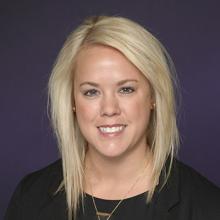
Stacy Lloyd
Director, Digital Health & Operations
American Medical Association
Stacy Lloyd is currently the Director of Digital Health and Operations at the American Medical Association. She has over 15 years of experience in finance and operations, digital health, innovation, and patient advocacy at leading healthcare organizations. Stacy also holds a Bachelors in Business Administration from Duquesne University and a Masters in Public Health from the University of Illinois at Chicago, and is a Board Certified Patient Advocate.
Stacy was diagnosed with VHL in 1999 at the age of 13. Since then, several other members of her family have also been diagnosed with the disease. She is personally and professionally invested in the future of healthcare and enjoys being a resource in this space for family, friends and other patients, so that they can be better informed and empowered in their own healthcare journeys.
Webinar: Overcoming Potential Barriers to RPM Implementation
Overview
While remote patient monitoring (RPM) has exploded in recent years, many providers are not equipped to purchase, set up, or manage RPM devices (especially multiple RPM solutions), not to mention the access and reimbursement needed to incentivize wide adoption. Clinicians are already time-constrained and creating additional administrative tasks would sacrifice other important office work or patient care.
How do we overcome this? How can we deliver a beneficial RPM experience while easing the burden a program could potentially place on physicians, staff, and patients? This online event covered solutions available to support providers with device setup, enrollment, and patient support.
Covered Points:
-
How are organizations looking to expand their programs as RPM solutions improve and become more reimbursable?
-
What are the processes for selecting which RPM solutions to implement?
-
What are the technical challenges being encountered as organizations implement more RPM?
-
How are organizations navigating technical challenges?
Featured Speakers:
- Beth Friedmann, RN, MSN, MA, AVP, Clinical Informatics, Northwell Health
- Colin Wearring, Sr. Product Manager, Redox
Sponsored by

Webinar: Removing the Barriers to Deliver a Whole Patient Experience
Overview
Today, patient engagement and individual care experience are top of mind amongst players in the healthcare industry, especially providers. To remain competitive, providers are considering patients more as customers and, as a result, are working to improve the overall healthcare experience and keep patients within their networks. This has placed priority on the whole patient journey, from clinical and administrative, to financial, and everything in between.
While great in theory, providers are facing challenges while attempting to ensure a positive whole patient experience. Staff shortages, manual, inefficient workflows, and disconnected and disjointed technology, all contribute to the barriers keeping providers from offering a positive patient journey. Watch this webinar to learn how executives can put their organizations in the position to deliver for their staff truly, and ultimately patients, by having a coherent acquisition and retention strategy, and ensuring that their information systems (including EHRs) are integrated, and where appropriate, automated so that staff can trust a unified source of information.
What you’ll hear:
- How are organizations approaching the whole patient journey?
- What are the top problems organizations are facing in addressing the patient experience?
- How are executives leveraging their investments in EHR platforms to ensure it’s the source of truth?
- What are the acquisition and retention tools that executives are using to remain competitive?
Featured Speakers:
- Kelsey Buhr, Manager, Design, and Innovation, Marshfield Clinic Health System
- Mike Peresie, SVP and GM, Decision Support and RCM Technology, Change Healthcare
- Neal Sanger, Administrator/Regional CIO, Mayo Clinic
- Tripp Welch, Vice Chair, Quality Management Services, Mayo Clinic
Sponsored by:

Webinar: Removing the Barriers to Deliver a Whole Patient Experience
Today, patient engagement and individual care experience are top of mind amongst players in the healthcare industry, especially providers. To remain competitive, providers are considering patients more as customers and, as a result, are working to improve the overall healthcare experience and keep patients within their networks.
Webinar: Using AI/Machine Learning for Patient Matching to Support Patient Safety and Improve Care
Overview
Access to accurate, complete, and timely data is one of the most valuable assets in any healthcare organization. Quality data improves care coordination, and clinical outcomes, and saves lives but can only be achieved with accurate patient identification or matching across multiple sources. Interoperable electronic health records (EHRs) allow the electronic sharing of patient information between these different sources, but sharing the data successfully requires the capacity to connect each patient with the correct record. Despite best practices in patient access and medical record management, patient matching issues including duplicate records and record overlays continue to be a major problem for health care.
During this session recording, you will learn how AI/Machine Learning Prediction is being used to further improve the patient match rate and ensure medical record data is accurately matched to the right patient identity.
Speakers
- Craig Jones, MD, Chief Medical Officer, Idaho Health Data Exchange
- Muthu Kuttalingam, Senior Vice President of Product Development and Technology, 4medica
Sponsored by
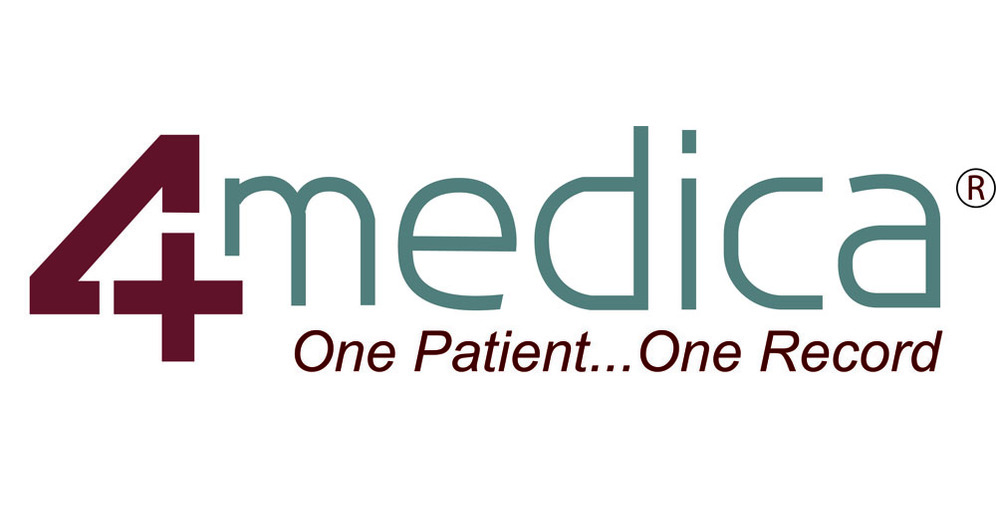
WEBINAR: The Current and Future State of Digital Health Credentials
Although digital health credentials are not new, they rose quickly to international attention in the wake of the COVID-19 pandemic and have stayed in the news given recent vaccine mandates.
Hear from experts in healthcare and health technology about where things stand now with respect to their benefits, at-times controversial implementation, ethical and privacy implications — and where we go from here.
Sponsored by:
Report: Clinical Communication and Collaboration: Redefining the Patient Journey for Better Outcomes
As the pandemic evolved, an added strain was placed on Emergency Departments (EDs) with the need to isolate COVID-19 patients from those seeking emergent care and non-COVID-19 care. Minimizing time spent in the ED or bypassing the ED altogether, along with the suspension of facility-based elective care, became a priority. This caused a shift in the traditional patient journey. There was a heightened interest in virtual assessments and notification systems to improve the flow of patients through EDs.
eHI collaborated with Everbridge to create this report.
WEBINAR: Providers Ditch Paperwork & Reduce Burden with AI
While healthcare organizations have been under tremendous financial stress during the COVID-19 pandemic, a recent United healthcare survey shows that 56% of healthcare organizations reported accelerating their artificial intelligence (AI) plans. Since the pandemic struck, investment in AI platforms has skyrocketed. In this webinar, we heard what is driving the current AI investments including cost savings, improved provider and patient experiences, reducing staff burnout and administrative burden.
- Learn how a cutting-edge platform uses AI and RPA to quickly eliminate repetitive operational tasks at scale by using existing administrative processes and applications (i.e. EHR, web-based apps)
- Hear experts discuss how healthcare organizations are investing in AI and automation technologies to cut costs, reduce staff burn-out, create resilience, and enhance the employee and patient experience

